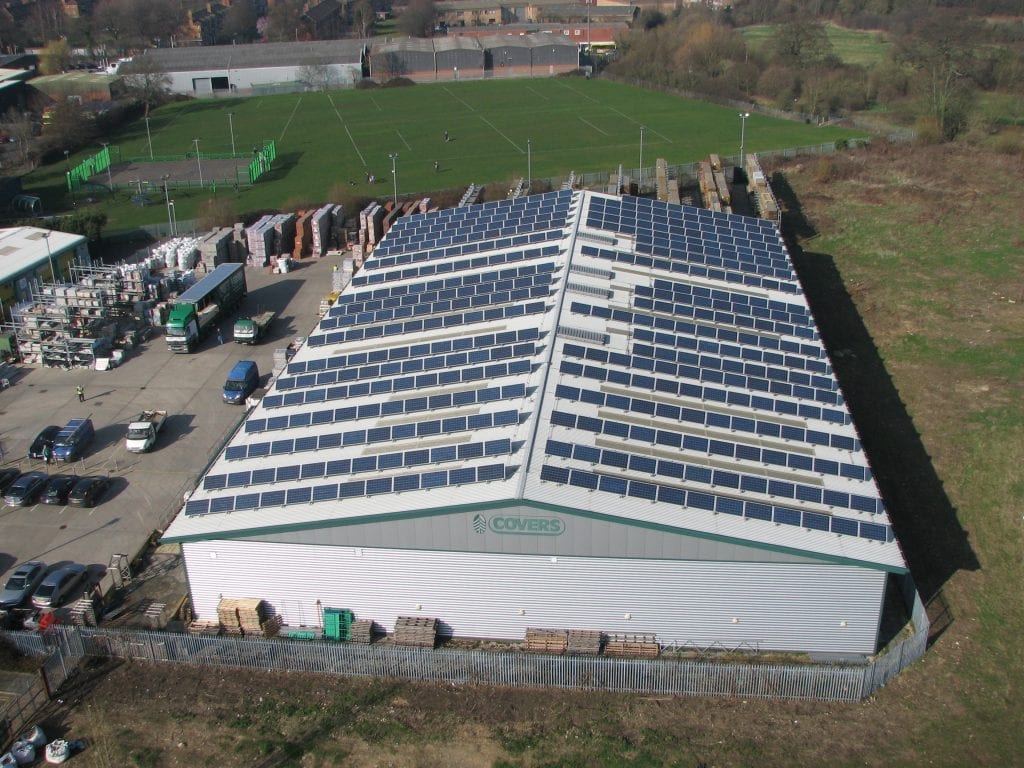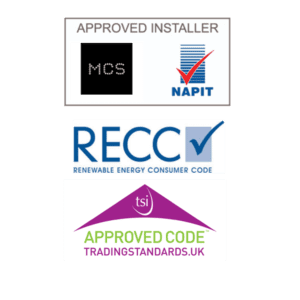How will installing solar panels help your business?
Save money by reducing your companies electricity bill
Installing less than 150 panels could provide your business with 50kW of peak power. This could produce around 50,000 kWh’s of electricity per year saving your business thousands on electricity.

Secure your businesses energy future
Energy prices are rising, and are expected to double over the next 10 years.
Businesses are already recording electricity as a significant cost to them, particularly manufacturing companies.
Secure your businesses energy future by reducing costs now. Solar panels are expected to last at least 20 years, however some of the oldest panels still working today are more than 40 years old.
Solar panels are able to provide you with free electricity and an income from the Smart Energy Guarantee (SEG).
Coupled with battery storage, solar panels can protect your business from rising energy costs and potential blackouts.

Make a positive impact on the environment.
You could save 0.43 kg of CO2 emissions, for every unit of energy produced by solar panels.
This is a powerful marketing message and adds huge credibility to a company’s corporate social responsibility.
A monitoring dashboard displaying CO2 savings and solar production could be placed in the business reception area.

Commercial solar panels are a great choice for businesses.
A vast majority of businesses in the UK use electricity during the day. Solar power is generated during daylight hours, which is why entities can make significant savings on their electricity costs. If your company has high electricity usage you can benefit from solar the most.
Even smaller companies that have lower electricity consumption will still see large savings.
The steps to installing solar panels for commercial clients.
Installing solar panels on your commercial building has several steps. As a company, we work to the following procedure.
1) Initial enquiry
Businesses contact us for an initial discussion as to whether it’s possible to install solar panels in their commercial environment. At this stage to ensure that we design the system that suits your financial requirements, we will briefly discuss costs and budgets.
We will discuss your company’s solar panel requirements. It is important to understand your companies motivation and any particular requirements at this stage.
2) Desktop survey
Generally, it’s pretty easy to complete a desktop survey. When considering Solar Panels for Commercial Buildings, initially we will scope the site using google earth. We will start to calculate the orientation, pitch and area of your roof. 90% of the time we will be able to identify the most suitable space for the solar panels at this stage.
3) Initial Quotation
Taking into account all the information gathered up to this point we should be in a position to quote for Solar Panels for your commercial building. At this stage, the quote is subject to a site survey but it’s comprehensive enough for you to formulate a budget.
4) Site Survey
If the project is looking feasible both from an engineering standpoint and is within budget a site visit is then booked with both our roofing and electrical technicians.
We are not a sales company so there will not be a hard sell. It’s simply a feasibility study to check that everything can be done as we have said in our initial quotation.
5) Final Quotation
We are now at a stage where we can issue our final quotation making adjustments for anything we may have found during our site survey. For example we may have found that there is a need for additional electrical requirements or roofing improvements. This quote is final although will have a time limit and some exclusions such as anything that the DNO also known as District Network Operator require or any extras that become apparent following any structural surveys etc.
6) Planning Stage
Although actual planning permission may not be needed planning is important to move forward. Work needs to be done such as technical drawings, electrical calculations, structural surveys and DNO applications.
In short, the DNO application is getting permission to connect to the grid. All systems above 16 Amps or 3.68 Kilowatts per phase must be applied for.
If it is a ground mounted solar installation then ground studies must take place prior to starting. Because of the workload we ask for a fee at this point. Usually to be deducted from the final bill should the project progress.
7) Pre-start meeting
Installing solar panels on commercial buildings can have its complications. It is important to discuss these complications and site requirements before work commences. This like site rules, health and safety, access and welfare facilities will be amongst the topics discussed.
8) Access / Scaffolding
When installing solar on a commercial building it is likely that scaffolding will be needed. This will be installed prior to the installation of the solar panels. Most solar installer use sub-contract scaffolding companies.
9) Installation
Once the solar panels have been delivered along with mounting materials installation will start. Installation times vary but as a guide a 50kW installation could be completed in as little as one week.
Mounting kit is installed to the roof structure and panels are fastened down as the installers work along the roof. Each panel is connected by a qualified solar electrician. Roofing works will be happening at the same time as electrical works.
The solar panels will be connected into strings as per the design these will then be connected into the inverter(s). It is likely that more than one inverter will have to be installed but this will depend on the size of the installation.
10) Commissioning
After the solar panels and inverters have been installed the system will need testing and the results recorded onto commission certificates.
The solar installers will be testing for voltage and current. They will be expecting to get values within a known range depending on solar radiance (how bright the sun is shining).
If the values are correct then the system is switched on and the inverters are configured. If the values are incorrect then fault finding begins until the reason is found and corrected.
The electrical installation is also checked and certain earth values and resistances are checked and recorded. These will form part of the Electrical installation certificate.
11) Handover
Once commissioning is finished, all the checks have been completed and are satisfactory we will start the handover process.
It is best that a handover session is booked with site maintenance staff, managers and others involved in the solar panels being installed. The system is demonstrated to the customer and maintenance staffs are made aware of how to start up and shut down the system, if needed.
A handover pack is produced. This usually contains the following:
A handover certificate that shows the components that have been installed, their warranties and other basic information about the system.
An Electrical installation certificate, all solar installations will have an electrical installation of at least one circuit, therefore an electrical certificate must be provided to the building owner.
PV Test result sheets, each string of solar panels will have been tested for things like voltage, current, insulation resistance and polarity. All these probably don’t make any sense to most people. It is vital that these are recorded because it a record to show that the system was checked and is working correctly. The results will make sense to most electricians and ma come in hand for future maintenance checks.
MCS Certification, all systems up to 50kW require an MCS certificate. It forms part of the handover and is given once the system has been commissioned.
Schematic Diagram, a schematic diagram is basically an electrical layout in a line diagram format. It can be fairly basic in most domestic solar installations. They can be more complex when installing solar panels on a commercial building. Commercial buildings usually have more complex electrical systems and it is important that the schematics tie in with the existing so that the make sense.
Panel and Inverter Warranties, pretty standard when handing over any type of equipment. It goes without saying that these should be kept safe with the solar handover documents incase anything does go wrong.
Panel and Inverter Information, it is important to retain the official documents that show the exact make and model of the equipment being used. For example you may have installed Yingli 250W panels, but there is more than one type of Yingli 250W panel. It’s not always easy to pop onto the roof and check the back of the panel as to which make and model you had. It may never be necessary to know, but if you had to claim a warranty it would be important then.
12) Maintenance
We like to think of Solar PV Panels as fit and forget technology. (kind of). If you compare it with other renewable technologies such as solar thermal and Air source heat pumps the maintenance list seems rather short.
So what’s needed in the maintenance schedule? For commercial buildings and larger solar installations we recommend that some preventive maintenance is periodically completed. Tasks such as checking cables, ensuring circuit breakers are function correctly and checking earth paths amongst other things. If a potential issue can be prevented then there will be no lost yield.
Things can happen, inverters, trip switches and cabling have all been known to fail. It would make sense to have a corrective maintenance plan with your installer. An agreement can be set up so that a response target time is met. For example a 48 hour turn around. This aids to reduce yield loss. It’s important to protect your investment.
There have been studies that prove solar panel cleaning increases solar yield. We recommend using de-ionised water. Good window cleaning companies have long extendable brushes. There isn’t a major difference between glass and solar panels making cleaning an ideal job for window cleaners.
Benefits of Commercial Solar Panels
If you’re thinking of installing solar panels on your commercial building you are likely mulling over the many benefits already. Or maybe you’re looking at your competitor’s roofs with envy thinking why solar panels for commercial buildings? What are the benefits? Well, there is many.
Take control of rising energy prices
It will depend on our business but pretty much all businesses that own a commercial building will be looking at the cost of electricity and thinking I need to take control of this. If you are like our managing director your be looking at the figures and comparing them year on year. Whichever way you look at it and whatever you hear, electricity is continuing to rise. Solar panels will enable you to produce some of your own electricity and start to gain some control.
Reduce your companies CO2 emissions
Installing solar panels will enable your business to cut its CO2 emissions. If you’re paying the Carbon Tax Levy you could make some savings or even better be exempt.
Tax Breaks for businesses
At Present Solar PV systems fall under what is known as the annual investment allowance. Businesses can recoup tax spent on equipment and assets of up to £25,000.
Show your customers you care
Having a huge solar PV array on your commercial building can be a great marketing tool. Not only will you be the talking point but also you can produce some material that shows you care. Tell your customers how much CO2 your saving and how green your company has become.
SEG Payment (Smart Export Guarantee)
For every unit of electricity you don’t use you can get paid for by send it back to the national grid by a SEG provider such as Octopus Energy, who offer competitive rates for exported electricity.




